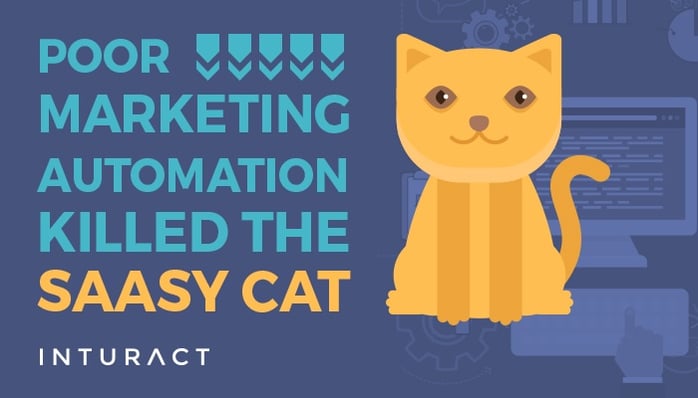
You’ve been on this road before and you recognize the signs.
They sign up for a free trial, and never click another button. They’ve dropped off the face of the earth for all you know. So you send them an email extending their free trial, and sweeten the deal with a freebie offer.
They open that email (of course they do!), only to discover that the product they would have paid for (probably…eventually…when they found the time) is essentially free to them, and that sends them into a tailspin of questioning your credibility as a company and the worth of your SaaS product.
Marketing automation just created a roadblock – in fact, it may have blown up a whole bridge on your highway to Salesville.
You don’t have to fall victim to SaaS marketing automation gone wrong. You can send tailored emails to the right audience, offers that complement your service and teach your customer how to successfully use your product at the same time.
Poor Marketing Automation Killed the SaaSy Cat, but (Customer) Satisfaction Brought Him Back
Automation goes bad very quickly when it’s laid over a faulty foundation. Essentially, you can’t market successfully (automated or otherwise) to leads who don’t fall into your ideal customer profile.
If the goal of your automated marketing is to supply sales with qualified leads…
First, you have to attract those qualified leads, which requires you to identify your ideal customer, build a profile, and create an inbound strategy of content that offers unique value to that lead.
Sometimes, we’ve found that the content marketing efforts made by new clients are attracting leads – but they’re the wrong leads. If you’re getting lots of interest, but little follow-through, you may need a slight keyword and content topic adjustment. The goal is to make it equally clear who your product is for – and who your product is not for.
But customers don’t come in just two flavors. You’ll need to segment your audience so you never send the same message to everyone (you are not a one-size-fits-all commodity). Depending on your automation tool, you can segment audiences based on interests, behaviors, and other relevant factors you derive from your fully-fleshed-out customer profile.
About that content…
Content fuels marketing automation. It’s the bait on the hook – the reason people are willing to give you their contact information in the first place. So it has to be ridiculously good, because you have a lot of competition out there! Just like building a new product, you have to position your content with differentiators. You might be the 101st website to offer tips on increasing efficiency with Feng Shui (promoting your handy Feng Shui Office app), but perhaps only your site also features users who have successfully Feng Shui’d their desks and post it to your Instagram.
Once again, segmentation is key to drafting an effective content marketing strategy.  Your goal is to measure which types of content resonate for each segment and plan your content calendar based off of that. From there, you could even offer different eBooks for each segment. Using our Feng Shui Office app example, you could offer a newsletter just for Home Offices, another for Corporate Offices, and another for Silicon Valley Startups.
Your goal is to measure which types of content resonate for each segment and plan your content calendar based off of that. From there, you could even offer different eBooks for each segment. Using our Feng Shui Office app example, you could offer a newsletter just for Home Offices, another for Corporate Offices, and another for Silicon Valley Startups.
Once you have the right audience and valuable content…
Now it’s time to introduce automation. You’ll need to set out measurable goals you intend to meet with your automation and tie those goals to your company’s goals. Be sure to include measurable key performance indicators to let you know how much progress you’re making.
The goal of automation is to warm up leads for your sales people, educating them, inspiring them, and showing them how they can achieve their desired results with your product. When your automated marketing hits all of those notes, your sales team will sing your praises – because you’ve just done the heavy lifting for them.
When crafting your automated marketing messages, let customer success be your guiding principle: What information can you offer prospects that will help them achieve their desired results? 
These messages will form the core of your lead nurturing campaigns, when prospects aren’t ready for a sales message, but are interested in what you have to offer. Once users show signs of engagement (by reading these communications), you can send a salesperson in to “answer any questions” – or better yet, offer to show the segmented prospect how they can achieve a specific goal.
The most prevalent mistake we see people make with automation is expecting it to work like marketing-on-autopilot. Yes, once you set up your target customer profiles, segment accordingly, produce compelling content, set measurable goals and go in with a plan to gently nurture leads according to customer success principles – it’s practically “set it and forget it.” But if you haven’t laid that foundation, you might as well be asking people to sign up for junk mail.
You can do better. And, marketing automation can help.
Do you have automation set up but you aren’t totally satisfied with your results? We’ll be happy to take a look at your SaaS marketing to see if you have any quick wins and / or long term strategies for opportunities to improve.


